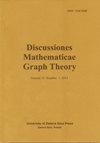朋友-陌生人图的连通性和循环空间
IF 0.5
4区 数学
Q3 MATHEMATICS
引用次数: 9
摘要
如果$X=(V(X),E(X))$和$Y=(V(Y),E(Y))$是$n顶点图,那么它们的朋友和陌生人图$\mathsf{FS}(X,Y)$是顶点是从$V(X)$到$V(Y)$的双射的图,其中$\sigma$和$\sigma'$相邻,当且仅当在E(X)$中有一条边$\{\sigma(a),\sigma(b)\}\ \在E(Y)$和$\sigma'=\sigma\circ (a\,\,b)$,其中$(a\,\,b)$是$V(X)$交换$a$和$b$的排列。我们证明了为$\mathsf{FS}(X,Y)$连通提供充分必要条件的一般定理。作为推论,我们得到了图$Y$的完全刻画,使得$\mathsf{FS}(\mathsf{Dand}_{k,n},Y)$是连通的,其中$\mathsf{Dand}_{k,n}$是蒲公英图;这实质上推广了第一作者和Kravitz在k=3情况下的一个定理。对于$Y$的特定选择,我们描述爬行图$X$,使得$\mathsf{FS}(X,Y)$是连通的。以不同的方式,我们研究朋友和陌生人图的循环空间。Naatz证明了如果$X$是一个路径图,则$\mathsf{FS}(X,Y)$的循环空间由$4$-cycles和$6$-cycles张成;我们证明,当$X$是一个循环并且$Y$的支配数至少为$3$时,同样的语句成立。当$X$是一个循环并且$Y$的支配数至少为$2$时,我们的证明揭示了$\mathsf{FS}(X,Y)$中的游动在特定的Coxeter移动下的行为。本文章由计算机程序翻译,如有差异,请以英文原文为准。
Connectedness and cycle spaces of friends-and-strangers graphs
If $X=(V(X),E(X))$ and $Y=(V(Y),E(Y))$ are $n$-vertex graphs, then their friends-and-strangers graph $\mathsf{FS}(X,Y)$ is the graph whose vertices are the bijections from $V(X)$ to $V(Y)$ in which two bijections $\sigma$ and $\sigma'$ are adjacent if and only if there is an edge $\{a,b\}\in E(X)$ such that $\{\sigma(a),\sigma(b)\}\in E(Y)$ and $\sigma'=\sigma\circ (a\,\,b)$, where $(a\,\,b)$ is the permutation of $V(X)$ that swaps $a$ and $b$. We prove general theorems that provide necessary and/or sufficient conditions for $\mathsf{FS}(X,Y)$ to be connected. As a corollary, we obtain a complete characterization of the graphs $Y$ such that $\mathsf{FS}(\mathsf{Dand}_{k,n},Y)$ is connected, where $\mathsf{Dand}_{k,n}$ is a dandelion graph; this substantially generalizes a theorem of the first author and Kravitz in the case $k=3$. For specific choices of $Y$, we characterize the spider graphs $X$ such that $\mathsf{FS}(X,Y)$ is connected. In a different vein, we study the cycle spaces of friends-and-strangers graphs. Naatz proved that if $X$ is a path graph, then the cycle space of $\mathsf{FS}(X,Y)$ is spanned by $4$-cycles and $6$-cycles; we show that the same statement holds when $X$ is a cycle and $Y$ has domination number at least $3$. When $X$ is a cycle and $Y$ has domination number at least $2$, our proof sheds light on how walks in $\mathsf{FS}(X,Y)$ behave under certain Coxeter moves.
求助全文
通过发布文献求助,成功后即可免费获取论文全文。
去求助
来源期刊

Discussiones Mathematicae Graph Theory
MATHEMATICS-
CiteScore
2.20
自引率
0.00%
发文量
22
审稿时长
53 weeks
期刊介绍:
The Discussiones Mathematicae Graph Theory publishes high-quality refereed original papers. Occasionally, very authoritative expository survey articles and notes of exceptional value can be published. The journal is mainly devoted to the following topics in Graph Theory: colourings, partitions (general colourings), hereditary properties, independence and domination, structures in graphs (sets, paths, cycles, etc.), local properties, products of graphs as well as graph algorithms related to these topics.
 求助内容:
求助内容: 应助结果提醒方式:
应助结果提醒方式:


